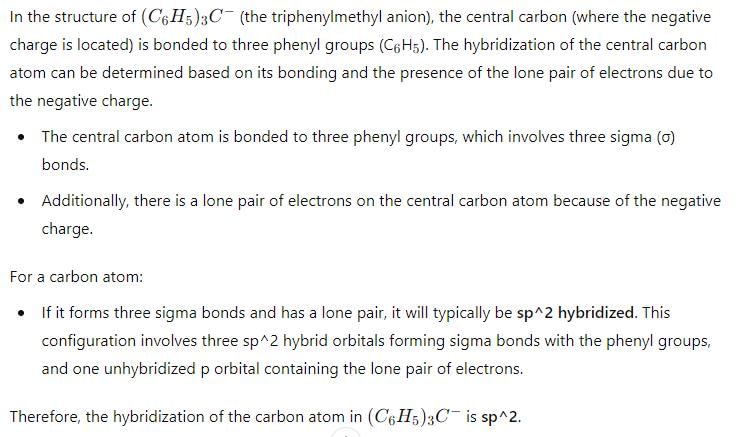Chemistry Exam > Chemistry Questions > Hybridization in (C6H5)3C– (on negative...
Start Learning for Free
Hybridization in (C6H5)3C– (on negative carbon) is:
- a)sp
- b)sp2
- c)sp3
- d)sp3d
Correct answer is option 'B'. Can you explain this answer?
Verified Answer
Hybridization in (C6H5)3C– (on negative carbon) is:a)spb)sp2c)sp...

Most Upvoted Answer
Hybridization in (C6H5)3C– (on negative carbon) is:a)spb)sp2c)sp...
Hybridization in (C6H5)3C (on negative carbon) is sp2.
Explanation:
1. Determine the central atom: In this case, it is the carbon atom with the negative charge.
2. Count the total number of valence electrons on the central atom: Carbon has 4 valence electrons, and there are 3 phenyl groups attached to it, each with 6 valence electrons. The negative charge adds an extra electron, so the total number of valence electrons is 4 + 3(6) + 1 = 23.
3. Determine the number of electron pairs around the central atom: In this case, there are 4 electron pairs around the central atom (3 bonds and 1 lone pair).
4. Determine the hybridization: The number of electron pairs around the central atom suggests sp3 hybridization, but the phenyl groups are bulky and prevent the lone pair from participating in bonding. Therefore, the lone pair stays in an unhybridized p orbital and the hybridization becomes sp2.
5. Draw the Lewis structure: The carbon atom is bonded to three phenyl groups and has a lone pair in an unhybridized p orbital.
Overall, the hybridization in (C6H5)3C (on negative carbon) is sp2 due to the presence of bulky phenyl groups that prevent the lone pair from participating in bonding.
Explanation:
1. Determine the central atom: In this case, it is the carbon atom with the negative charge.
2. Count the total number of valence electrons on the central atom: Carbon has 4 valence electrons, and there are 3 phenyl groups attached to it, each with 6 valence electrons. The negative charge adds an extra electron, so the total number of valence electrons is 4 + 3(6) + 1 = 23.
3. Determine the number of electron pairs around the central atom: In this case, there are 4 electron pairs around the central atom (3 bonds and 1 lone pair).
4. Determine the hybridization: The number of electron pairs around the central atom suggests sp3 hybridization, but the phenyl groups are bulky and prevent the lone pair from participating in bonding. Therefore, the lone pair stays in an unhybridized p orbital and the hybridization becomes sp2.
5. Draw the Lewis structure: The carbon atom is bonded to three phenyl groups and has a lone pair in an unhybridized p orbital.
Overall, the hybridization in (C6H5)3C (on negative carbon) is sp2 due to the presence of bulky phenyl groups that prevent the lone pair from participating in bonding.
Free Test
FREE
| Start Free Test |
Community Answer
Hybridization in (C6H5)3C– (on negative carbon) is:a)spb)sp2c)sp...
Given the carbanion, R3C−, the carbon is sp3 hybridized, unless it is participating in resonance. This is clear from its steric number. And Here negative participate in resonace as a (C6H5)3 is thre therefore it is SP2.

|
Explore Courses for Chemistry exam
|

|
Question Description
Hybridization in (C6H5)3C– (on negative carbon) is:a)spb)sp2c)sp3d)sp3dCorrect answer is option 'B'. Can you explain this answer? for Chemistry 2025 is part of Chemistry preparation. The Question and answers have been prepared according to the Chemistry exam syllabus. Information about Hybridization in (C6H5)3C– (on negative carbon) is:a)spb)sp2c)sp3d)sp3dCorrect answer is option 'B'. Can you explain this answer? covers all topics & solutions for Chemistry 2025 Exam. Find important definitions, questions, meanings, examples, exercises and tests below for Hybridization in (C6H5)3C– (on negative carbon) is:a)spb)sp2c)sp3d)sp3dCorrect answer is option 'B'. Can you explain this answer?.
Hybridization in (C6H5)3C– (on negative carbon) is:a)spb)sp2c)sp3d)sp3dCorrect answer is option 'B'. Can you explain this answer? for Chemistry 2025 is part of Chemistry preparation. The Question and answers have been prepared according to the Chemistry exam syllabus. Information about Hybridization in (C6H5)3C– (on negative carbon) is:a)spb)sp2c)sp3d)sp3dCorrect answer is option 'B'. Can you explain this answer? covers all topics & solutions for Chemistry 2025 Exam. Find important definitions, questions, meanings, examples, exercises and tests below for Hybridization in (C6H5)3C– (on negative carbon) is:a)spb)sp2c)sp3d)sp3dCorrect answer is option 'B'. Can you explain this answer?.
Solutions for Hybridization in (C6H5)3C– (on negative carbon) is:a)spb)sp2c)sp3d)sp3dCorrect answer is option 'B'. Can you explain this answer? in English & in Hindi are available as part of our courses for Chemistry.
Download more important topics, notes, lectures and mock test series for Chemistry Exam by signing up for free.
Here you can find the meaning of Hybridization in (C6H5)3C– (on negative carbon) is:a)spb)sp2c)sp3d)sp3dCorrect answer is option 'B'. Can you explain this answer? defined & explained in the simplest way possible. Besides giving the explanation of
Hybridization in (C6H5)3C– (on negative carbon) is:a)spb)sp2c)sp3d)sp3dCorrect answer is option 'B'. Can you explain this answer?, a detailed solution for Hybridization in (C6H5)3C– (on negative carbon) is:a)spb)sp2c)sp3d)sp3dCorrect answer is option 'B'. Can you explain this answer? has been provided alongside types of Hybridization in (C6H5)3C– (on negative carbon) is:a)spb)sp2c)sp3d)sp3dCorrect answer is option 'B'. Can you explain this answer? theory, EduRev gives you an
ample number of questions to practice Hybridization in (C6H5)3C– (on negative carbon) is:a)spb)sp2c)sp3d)sp3dCorrect answer is option 'B'. Can you explain this answer? tests, examples and also practice Chemistry tests.

|
Explore Courses for Chemistry exam
|

|
Signup for Free!
Signup to see your scores go up within 7 days! Learn & Practice with 1000+ FREE Notes, Videos & Tests.



















